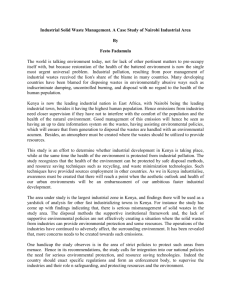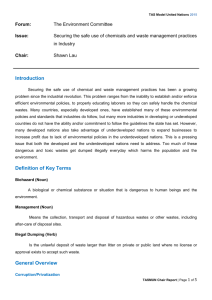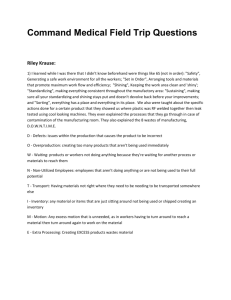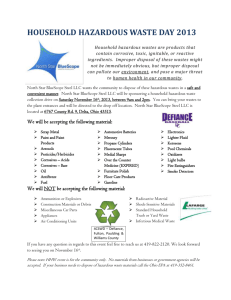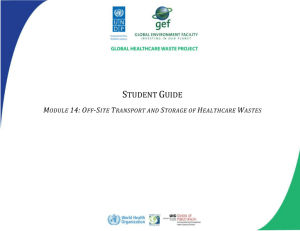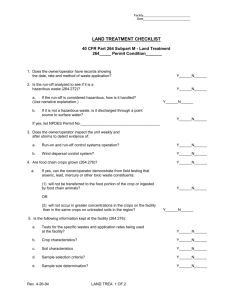An integrated national waste management strategy
advertisement
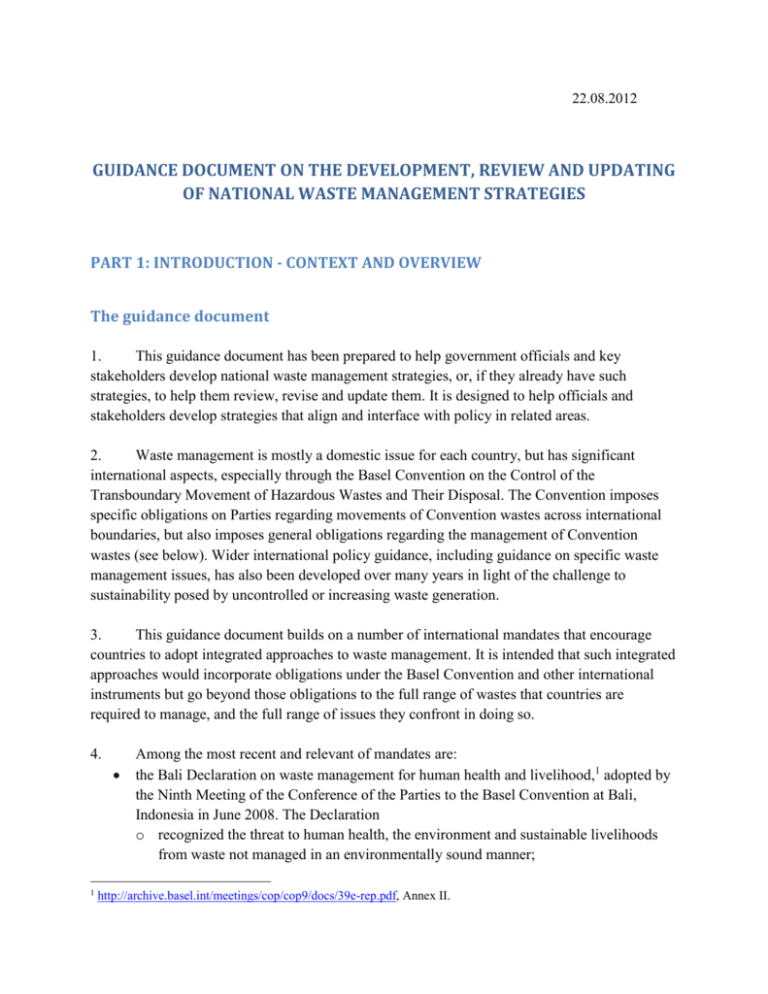
22.08.2012 GUIDANCE DOCUMENT ON THE DEVELOPMENT, REVIEW AND UPDATING OF NATIONAL WASTE MANAGEMENT STRATEGIES PART 1: INTRODUCTION - CONTEXT AND OVERVIEW The guidance document 1. This guidance document has been prepared to help government officials and key stakeholders develop national waste management strategies, or, if they already have such strategies, to help them review, revise and update them. It is designed to help officials and stakeholders develop strategies that align and interface with policy in related areas. 2. Waste management is mostly a domestic issue for each country, but has significant international aspects, especially through the Basel Convention on the Control of the Transboundary Movement of Hazardous Wastes and Their Disposal. The Convention imposes specific obligations on Parties regarding movements of Convention wastes across international boundaries, but also imposes general obligations regarding the management of Convention wastes (see below). Wider international policy guidance, including guidance on specific waste management issues, has also been developed over many years in light of the challenge to sustainability posed by uncontrolled or increasing waste generation. 3. This guidance document builds on a number of international mandates that encourage countries to adopt integrated approaches to waste management. It is intended that such integrated approaches would incorporate obligations under the Basel Convention and other international instruments but go beyond those obligations to the full range of wastes that countries are required to manage, and the full range of issues they confront in doing so. 4. 1 Among the most recent and relevant of mandates are: the Bali Declaration on waste management for human health and livelihood,1 adopted by the Ninth Meeting of the Conference of the Parties to the Basel Convention at Bali, Indonesia in June 2008. The Declaration o recognized the threat to human health, the environment and sustainable livelihoods from waste not managed in an environmentally sound manner; http://archive.basel.int/meetings/cop/cop9/docs/39e-rep.pdf, Annex II. 2 o reaffirmed international commitment to the principles and purposes of the Basel Convention; o noted the Convention’s contribution to sustainable development through waste prevention and minimization, environmentally sound management of waste, and management of the transboundary movement of waste; and o renewed commitment by the Parties to waste prevention and minimization, the control of transboundary movements of hazardous wastes and safe and environmentally sound management of waste as means of addressing the threats to health and to livelihoods from the uncontrolled generation of hazardous and other wastes. the Cartagena Declaration on the prevention, minimization and recovery of hazardous wastes and other wastes,2 adopted by the Tenth Meeting of the Conference of the Parties to the Basel Convention at Cartagena, Colombia in October 2011. The Declaration o committed to the promotion and implementation of strategies for preventing and minimizing waste, especially minimizing the generation of wastes at source so as to decouple economic growth from the impacts associated with waste; o recognised the economic potential and benefits of waste recovery operations, where the generation of wastes cannot yet be avoided; o recognised the importance to policy and decision-making of information on waste generation and management, and encouraged the collection and reporting of data on waste; and o encouraged all the sectors involved to cooperate with each other to deliver better outcomes. Resolution WHA63.253 of the World Health Assembly at its 63rd meeting, in May 2010, which o recognised the potential threat to human health from wastes if not properly managed, in particular health-related wastes; o supported the implementation of the Bali Declaration; and o called for strategies to minimise the generation of health-related wastes. Decision 25/8 on waste management,4 adopted by UNEP Governing Council at its 25th meeting in 2010, which o supported integrated waste management; and o encouraged implementation of the Bali Declaration. Part IV of Decision 26/35 adopted by UNEP Governing Council, meeting as the 2011 Global Ministerial Environment Forum, which o reiterated support for integrated approaches to waste management; and http://www.basel.int/Portals/4/Basel%20Convention/docs/meetings/cop/cop10/CartagenaDeclaration.pdf. http://apps.who.int/gb/ebwha/pdf_files/WHA63-REC1/WHA63_REC1-P2-en.pdf. 4 UNEP/GC.25/17, see http://www.unep.org/gc/gc25/working-docs.asp. 5 http://www.unep.org/gc/gc26/docs/Proceedings/K1170817_E-GC26-19_Proceedings.pdf. 3 5. o encouraged improvements in waste prevention and management, including in the field of e-waste. Paragraph 218 of the ‘The Future we Want’,6 the main outcome document of the UN Conference on Sustainable Development, June 2012, which called for the development and enforcement of comprehensive national and local waste management policies, strategies, laws and regulations. A list of related mandates is provided at Annex A. 6. This guidance document is aimed at assisting countries to address the above mandates through their policy/strategy development on waste management. The intention is to provide a conceptual and methodological framework that countries may then apply and adapt to their particular circumstances. In particular, this guidance document outlines a possible process that countries may wish to consider; and poses questions that countries may wish to address as they develop integrated national waste management strategies. 7. The guidance document was developed by UNEP’s International Environment Technology Centre (IETC) and UNITAR. A reference group of representatives from interested countries and relevant international organisations has been established. This reference group (see membership at Annex B) [will provide/has provided] comment on successive drafts. IETC and UNITAR have also invited comment on drafts from their stakeholder networks. The intention is to keep this guidance under regular review to maintain its continued usefulness. Further comment on it is therefore invited. Waste management - challenges to governments and communities 8. It is in the nature of waste management that it presents a series of challenges to governments as they attempt to formulate effective policies. Challenges to sustainable development 9. First, continued or accelerating rates of generation of waste provide one of the clearest challenges to sustainability. Even at the basic level of common sense, it is evident that continued and growing waste generation cannot continue indefinitely, and is in that sense unsustainable. But on closer examination it becomes clear that waste generation challenges every principle and concept in sustainable development: 6 Sustainability problems often arise where one of the dimensions of sustainability pursued at the expense of the others, but uncontrolled waste generation offends all at once: it is inefficient use of resources and is therefore poor economic policy; it imposes a wide range of environmental impacts and is therefore poor environmental policy; and it involves loss of social amenity and impacts on health and is therefore poor social policy. Waste management http://daccess-dds-ny.un.org/doc/UNDOC/LTD/N12/436/88/PDF/N1243688.pdf?OpenElement. if done badly leads not so much to a failure to reconcile competing policy interests, but to absolute policy failure against all three ‘pillars’ of sustainability. Thus it is the very antithesis of sustainability. Poor waste management inevitably passes on problems to subsequent generations and is therefore inconsistent with intergenerational equity. Typically, waste management if badly done imposes its highest cost on some of the poorest members of society – for example children earning small amounts as scavengers. Waste management facilities are sited near low income communities. Thus waste management policy failures also breach the principle of intragenerational equity. Other principles of sustainable development – such as the precautionary principle – are also likely to be breached by policies that are not careful, balanced and integrated. Some of these are explored further below. 10. Typically, rates of waste generation increase with economic growth. Increased wealth leads to increased demand, increased production and consumption of goods and services, and increased waste generation as a result. Indeed, waste generation usually increases faster than wealth. Even where wealth is not significantly increasing, changes in the range of products on the market may lead to increased waste through the use of more disposable products or greater amounts of packaging; or the relative hazard of the waste may increase as product composition changes. There is a kind of vicious circle of production and consumption, as each feeds on the other, and the consequences of this circle are seen in increasing quantities of waste, compounded by changes in composition. The challenge for waste management policy is to break the circle and tackle the waste issue from the start of the process to the end. 11. Part of the difficulty for governments is that the choices of each consumer over what to buy, wear, use and dispose of is very much an individual matter that governments do not usually try to dictate. But these choices have major implications for waste management. The most straightforward way to encourage producers to create products that will subsequently present preferable options for waste management is to stimulate demand for such products by consumers. The choices made by producers and consumers have a long chain of consequences down the lifetime of the product and beyond; ultimately success in waste management will require consumption choices to be modified, and for producers to adjust their operations so as to meet those modified demands. Challenges arising from the composition of waste 12. Many wastes are by their nature difficult to manage. Municipal solid waste (MSW), for example, is typically highly heterogeneous in composition, containing a significant proportion of putrescible components, such as food waste, as well as other components such as packaging waste and household goods (e.g. rags, cleaning agents, batteries or discarded pharmaceuticals) and may contain other kinds of waste mingled with it, such as healthcare wastes (e.g. from doctors’ surgeries or clinics or home healthcare). Some of these components are, or may be, hazardous. MSW usually has high moisture content, and therefore low calorific value (and so is not an ideal fuel for incinerators). The nature of such wastes – often mixed, wet, contaminated and of low value - presents difficulties in management. 13. Many industrial wastes are consistent in composition, but may still present problems in management because they are, or may be, hazardous, or contaminated with materials that require special management. The capacity to manage wastes successfully may also be challenged by variability in the amounts and composition of wastes, which will affect the economics of recycling and reuse as well as disposal options. 14. Some wastes are by their nature difficult to treat. Persistent organic pollutants (POPs) are by definition persistent chemicals and many are resistant to treatment by simple chemical breakdown.7 Similar considerations apply to many of the chemicals phased out under the Montreal Protocol on Substances that Deplete the Ozone Layer, as many of them are also typically halogenated compounds.8 15. A different and more difficult problem confronts waste streams containing elements for which there are no or very limited uses. Examples include arsenic-containing wastes and these considerations may in future extend to mercury-containing wastes.9 16. Waste managers everywhere are hampered in their task by the inadequacy of the data and information with which they work. Waste is inherently difficult to collect data on, as it is variable and heterogeneous in composition, and low in value. Yet good decisions about waste require information and numerical data on which managers can rely. How to improve the quality of the information base during the process of reforming waste management is one of the fundamental challenges for waste managers. Environmental and health challenges 17. Wastes impose a series of impacts on health and the environment.10 The primary impacts arise, depending on the kind and composition of the waste, from: acute or chronic hazards to human health and the environment, for example o waste pharmaceuticals or pesticides; o industrial chemicals containing, or contaminated with, hazardous substances; o consumer products, such as some cleaning agents, containing hazardous chemicals; or o materials such as asbestos. 7 Guidance on the management and destruction of POPs wastes is available from the Basel Convention.See the list of technical guidelines at http://archive.basel.int/meetings/sbc/workdoc/techdocs.html. 8 See http://ozone.unep.org/Assessment_Panels/TEAP/Reports/Other_Task_Force/TEAP02V3b.pdf for a survey of technologies used for destruction of ozone-depleting substances. 9 Guidance on management of mercury wastes is under development under the Basel Convention – see http://archive.basel.int/techmatters/index.html. 10 Annex III to the Basel Convention lists characteristics of wastes that qualify them to be considered hazardous. Many of these hazardous characteristics have been further examined in the Technical Guidelines issued under the Convention. physical hazards o corrosive materials such as those found in some batteries or cleaners; or o flammable materials such as petroleum products, some solvents; infection hazards, such as used bandages or medical wastes. 18. Wastes also generate environmental impacts in other ways. When materials and products end up as wastes they represent a significant diversion of resources away from productive use: Paper and cardboard consigned to disposal represent a loss of forest/timber resources; Waste plastics represent a loss of resources through the petroleum used to manufacture them. Industrial waste may reflect inefficiencies in production processes. 19. Other impacts include those associated with waste management facilities, especially if poorly managed: emissions of acute and chronic air pollutants from incinerators, such as sulfur dioxide, dioxins and furans; health impacts associated with communities living near badly managed landfills, such as skin and diarrhoeal diseases; pollution of surface and groundwater by releases from facilities, e.g. releases of leachate from landfills; air emissions from open landfills which have caught fire or are burning on a continuous basis, or from refuse fires (the emissions from these events can be particularly hazardous because the combustion process is completely uncontrolled); emissions of greenhouse gases from landfills and incinerators (carbon dioxide and methane); the attraction of insects and vermin to waste facilities; floods and blocked drainage and sewerage systems because of poorly managed waste or accumulations of waste or litter; and impacts on wildlife or on the environment more widely from wastes as they make their way into the natural environment. Plastics are of particular concern because of their impacts on biodiversity (eg plastics swallowed by aquatic or marine wildlife). 20. A number of other practical challenges in waste management arise from wastes’ indirect impacts and impacts on amenity: for MSW odour is often an issue; odour has limited direct impacts on health, but in practice it influences the location of waste management facilities and is frequently a major concern for managers dealing with public acceptance issues. litter is unsightly and can have major impacts on public amenity, especially in the vicinity of waste management facilities; and waste management facilities may have impacts on amenity because of unsightliness. Economic challenges 21. ‘Waste’ is first of all an economic concept: it implies that resources are not being used efficiently. When resources are applied in ways that lead to their discarding as waste, the loss of those resources, assuming there was some other potential use for them, is (inter alia) an economic loss. There are also other costs involved: for example valuable land may be alienated as the demand for landfill space increases; and the amenity issues referred to above (eg odour, unsightliness) may reduce land values in the vicinity of waste disposal facilities. 22. More direct costs also flow from waste management: the impacts on health and the environment have economic costs for the community – the costs of loss of productivity, medical costs and the indirect costs associated with loss of environmental quality and ecosystem services. Frequently these costs are imposed on the community or particular members of it rather than borne by those who generate the wastes. 23. The costs most clearly associated with waste management are the direct costs of the waste management system – the capital costs of the infrastructure and equipment; the labour costs of those who work in waste management. For cities, waste management is an area of very high direct costs, requiring significant investment. If levels of waste continue to increase, and especially if both total and per capita waste generation is on an increasing path, it is a continuing challenge to find the investment necessary to keep pace with demand. With the costs come some economic benefits, which can be important for those wastes not avoided through prevention and minimisation: valuable resources may be productively recovered, through recycling and material recovery; waste management provides employment, sometimes for large numbers of people, as well as the other benefits of economic activity; energy may be extracted from incineration processes; greenhouse gas reductions may result from processing choices. Part of the challenge of waste management policy is to reconcile and accommodate these competing economic interests. 24. Against that background is the additional consideration that a large proportion of wastes are essentially of low value, so that the possible economic return on recovery operations is limited. That provides the context for efforts to minimise the generation of wastes or ensure that policy interventions do not leave a long tail of low value waste for disposal. Social challenges 25. Waste management presents special difficulties for managers because of its place in the social order. By definition waste is unglamorous, of low status, something to be kept out of sight. Successful waste management policies succeed in bringing waste management into the light, and making it a worthwhile activity in which people are willing to invest their intellect and career interests. The involvement of the informal sector and the underground economy in waste management varies considerably from country to country, but where it is a significant factor, that usually makes policy and its implementation more challenging. The kind of involvement will vary: o In some countries there is, at least anecdotally, significant involvement by organised criminal elements; o in other countries the major concern is the risk of illegal dumping of waste by members of the public or ‘cowboy’ operators in the private sector; o elsewhere there may be a significant informal workforce engaged in sorting, and in recovery of useful or saleable goods and materials. 26. Informal operations may involve health risks for those in the sector, and may lead to the creation of a class of people with a vested interest in the continued generation of waste. The absence of any organisation of these people and activities also renders them inherently difficult for governments to regulate; and entrenched poverty, in many cases, makes it difficult for governments to take policy decisions that might affect them adversely. On the other hand, development of a waste management strategy may present an opportunity to harness the energy of the informal sector and create a route out of poverty, if the right policy choices are made. 27. Successful waste management policy requires not only that community attitudes change, but also that community behaviour changes – that the people become involved in and contribute to waste minimisation. Governance challenges 28. Some of the challenges for governments come from the way in which waste management policy presents particular difficulties and complexities for governments grappling with the choices involved in policy development and implementation. Waste management serves many different objectives, with some of these reinforcing each other and others in tension. From time to time trade-offs and choices will need to be made. This makes for complex decision-making, which requires that the impact on other areas of policy be constantly kept under review. Among the objectives of waste management, typically, are: o the provision of public services; o protection of public health; o protection of the environment; o contributing to development, including through fostering and developing waste recovery and recycling operations; o providing employment and the benefits of business operations generally; o contributing to energy generation. The many interests involved imply many players, whose contributions will need to be harnessed and whose interests will need to be recognised and accommodated: o Government, at national, local and where relevant provincial levels; The private sector, in various different roles – as producers, suppliers, service deliverers, recyclers, traders; o The community, as waste generator as well as a player in waste minimisation; o Workers in the waste management sector, including the informal sector where relevant; and o Non-government organisations, as lobbyists and sometimes as service providers. These interests and players also imply the need to ensure that waste management policy is properly integrated and coordinated with policy in other sectors, rather than developed in isolation. In particular, waste management policy needs to have effective interfaces with policy on transport, energy, water, land use, health, employment and labour, poverty alleviation and community organisation. A successful waste management policy requires a sophisticated policy and legislative infrastructure. Necessary elements are likely to include: o Legislation and subsidiary regulation; o Supporting institutions and coordination among them; o Supporting frameworks for waste recovery and recycling operations; o Means of influencing public attitudes and behaviour; and o Mechanisms for review and reform. These elements are explored further in Parts 2 and 3. o An important aspect of policy is to ensure that the weight and balance of policy across its different dimensions is appropriate. If there is overinvestment in final disposal, for example, there is no incentive for those who generate waste to reduce the amount they generate; on the other hand, if there is underinvestment the level of service to the community will be inadequate. It is important therefore that policy should move ahead in a balanced and organised way on several different aspects at once. Every field has its political challenges, and waste is no exception. An example is that community opinion often focuses on particular waste streams, even if rational scientific or economic analysis suggests that priorities should lie elsewhere. All these challenges must be confronted in a highly dynamic policy environment. That dynamism arises from several sources: o The range of products coming on to the market and patterns of demand and consumption are constantly changing in many sectors. The rise of the mobile phone (which functions in many places as much as a fashion accessory as a communications tool), and the rapid cycling of information technology in general, exemplify this trend. New technologies are appearing ever more rapidly, usually without regard to the potential for waste problems to appear at a later time. Examples include the batteries from hybrid and electric vehicles and new materials such as nanomaterials and composites. o Even where products themselves do not change rapidly, the materials used in them may do so. That in turn may require that material recovery operations adapt to a changing environment. An example is the move away from precious metals in electronic goods, which has had a profound effect on the economics of e-waste recovery. o Changes in the prices of materials may alternatively encourage and threaten recovery operations (for example current moderately high metals prices may collapse, leaving recovery operations uneconomic). o Waste management technology itself develops new options and opportunities from time to time; and some product innovation is aimed at improving waste management options (eg light weighting of beverage containers). o Demographic and geographic changes, for example the growth in cities, leads to rapid changes in local demand for waste management services, and may also supply labour for waste management operations. o As economies evolve in some countries, the choices of consumers change and the structure of industry shifts with changes in income and wealth. That also leads to changes in volume and composition of waste. Global and future challenges 29. Increasing attention is being paid internationally to the possibility of ‘tipping points’ at which various ‘planetary boundaries’ might be breached, with potentially irreversible results.11 There is much uncertainty about some of these predictions, but they are far-reaching, and in some cases it may be that tipping points have already been reached or the conditions for them to be reached are already in place. It may therefore be worth considering, in development of a national strategy, whether uncontrolled or unmodified waste generation may be pushing us towards some of these foreshadowed global tipping points, for example in areas such as climate change, biodiversity and chemical pollution. An integrated national waste management strategy 30. Waste management policies usually develop piecemeal, often at local level, and by the time national government takes a strategic interest there are often problems of contradictory and inconsistent policies at different levels and for different waste streams. Resources may be applied in ways that do not reflect national interests and priorities. The opposite may also occur – national policy may be developed in ways that overlook local needs, capacities, capabilities and practices. 31. The development of a national waste management strategy is not guaranteed to prevent these problems, nor to provide an answer to all the challenges identified above, but if conducted pragmatically and thoroughly, offers an opportunity of confronting many of the challenges and avoiding many of the pitfalls. 32. 11 The development of a national strategy should meet several complementary needs: See for example http://www.stockholmresilience.org/research/researchnews/tippingtowardstheunknown/thenineplanetaryboundaries. 4.1fe8f33123572b59ab80007039.html. It is strategic, in that it sets overall directions and adopts high level policy settings that guide lower level decisions. These are then available to all the players and provide consistency and coherence to policy as it is developed and applied. It provides a basis for setting priorities – for deciding what is most urgent and important, and for allocating resources accordingly. It is integrated, in the sense that the strategy is comprehensive, taking as its starting point the entire range of wastes that the country deals with, across all its territory and across the complete life cycle of the products and wastes. Subsequently, the process of developing the strategy involves narrowing that range by the process of priority setting. o The integrated nature of the strategy development process also allows the interaction among the environmental, economic and social aspects of waste management, and among all the players involved, to be taken into account. It offers an opportunity of illuminating and resolving competing interests and agendas. Strategy development allows the information base for waste management policy to be built up over time, so that data is gathered in a way that delivers consistent information. In turn, that feeds back into improved policy decisions. The strategy must operate at national level, even though much of the practical implementation may be at much lower level – for example, within local government. It is only at the national level that several critical decisions and judgments can be made: o International obligations operate at national level. o Some elements of policy require consistency across a country if they are to be effective (eg policies aimed at changing consumer attitudes, delivered through mass media). o The application of financial, regulatory and other measures implies national involvement; in particular, only national governments are likely to be in a position to mobilise the necessary financial resources for major increases in investment; o Recycling and recovery operations typically require national markets and economies of scale; o National action has the most promise for raising the profile of waste management as an industry and engaging the community in a debate that recognises everyone‘s potential contribution. A good national policy will incorporate the flexibility required for informed and sensitive implementation at local level, where that is necessary and can be done without injury to the policy as a whole. A national strategy requires frequent, or even constant, review because of the dynamism of the policy environment. A process of continuous review and revision is also useful because policy for different waste streams needs to be adjusted on a trial and error basis as some policy experiments will succeed and others will fail. Issues of scope 33. Ultimately, how each country chooses to set the scope and boundaries of its national waste management strategy is a matter for that country. Several considerations apply, however, to limit the scope of this guidance. 34. In the first place, this guidance does not extend to radioactive waste. Radioactive waste requires special and dedicated management. That extends to wastes deriving from applications of nuclear technology, or from mining of ores rich in radioactive materials. The International Atomic Energy Agency provides guidance to countries on the management of such wastes. 35. A number of wastes fall outside the scope of this guidance because they are subject to particular international regulation. Examples include in particular wastes associated with maritime operations: wastes arising from the normal operation of ships are covered by MARPOL 73/78; the dismantling and recycling of ships is the subject of the Hong Kong International Convention for the Safe and Environmentally Sound Recycling of Ships; wastes loaded onto a ship for disposal at sea are the subject of the London Convention (1972) and its 1996 Protocol. These issues are the province of the International Maritime Organisation (IMO). Once wastes have been taken off a ship, however, and once a ship has been dismantled, the resulting wastes become part of a country’s normal waste burden, and such wastes can be factored into a national waste management strategy like any others.12 36. Where wastes are loaded onto a ship for dumping at sea, they represent a diversion from a country’s waste streams. Such actions need careful examination from a policy point of view: the relevant international instruments strictly limit what Parties to those instruments may dump at sea, and from a policy perspective the action, if done on a continuing basis, represents an unsustainable course, as it runs counter to the Precautionary Principle. 37. The discharge of sewage, for example through ocean outfalls, is not within the scope of this document. International guidance on sewage disposal is available through the Global Programme of Action for the Protection of the Marine Environment from Land-based Activities (GPA).13 Some kinds of wastes from sewage treatment, such as sewage sludge, fall within this document and lend themselves to consideration under a national strategy. Other kinds of diversion of wastes to sea, for example mine or mineral processing waste pumped out to sea through pipelines as a slurry, also lend themselves to inclusion in a national strategy. 12 The Parties to the Basel Convention have given particular attention to the intersection of the interests of the Convention and those of the IMO. See for example Decision VIII/9 of the Basel Convention, at http://archive.basel.int/meetings/cop/cop8/docs/16eREISSUED.pdf#viii09. 13 http://www.gpa.unep.org/. 38. This document does not offer guidance on the assessment or remediation of contaminated sites. The wastes that are generated when remediation is undertaken, however, will need to be managed and would logically be included in a national strategy. 39. While, it is for each country to determine the scope of its strategy, it may be useful for countries to determine the boundaries by asking whether a given waste stream is amenable to the kinds of approaches typical of waste management at this strategic level – waste prevention and minimisation, cleaner production, the waste hierarchy, environmentally sound management. If so, inclusion in the strategic approach seems warranted.

